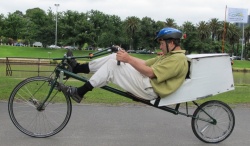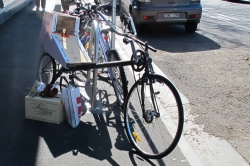MonsterbikeFWD
Hi, My name is Steve Nurse from Australia and I have been building a type of front wheel drive bike for about 6 years. The design is called the Monsterbike. I would like to see the design flourish and so have released a pdf plan of one version, see here
Here are some design guidelines for a Monsterbike.
- Front wheel drive, fixed botton bracket, recumbent bike with 700c, 26" or 24" front wheel and 20" rear wheel. With a 700c wheel, the chainstays are parallel to the main frame as shown in the photo above, with a 26" or 24" wheel, the chainstays are parallel to the ground as shown in the plan.
- Sloping main frame tube at about 20 degrees to the ground. This geometry means that a hole for the steerer tube drilled at a simple right angle through the frame will provide the right geometry for bike stability using standard geometry bike forks. I can ride my bikes no hands but not while pedalling.
- The small back wheel allows a simple, large carrying capacity tailbox to be built onto the bike. The back wheel does not interfere with the tailbox at all, and the tailbox adds visibility, storage capacity and aerodynamics to the bike.
- The seat height is about 600mm allowing for good visibility in traffic and easy stops and starts. It allows sidesaddle trundling of the bike on footpaths. Its a simple flowing manoevre to pick up the bike to go over a curb or gutter.
- Direct front wheel drive, 8 speed derailleur gears with no pulleys guiding the chain. Gearboxes (Schlumpf in bottom bracket or Sturmey Archer 3 x 8 in front wheel) have been used to add gearing range.
- The general ride quality relies on rear suspension. Having a large front wheel with good inate suspension characteristics a long way from the rider means front suspension is not required.
- On some of the bikes like the one shown above I use an inertia braking system, turning the brake handles toward the rider, and allowing the natural forward motion of the rider during decelleration to help activate the brakes. Also on the bike shown above there are 2 brakes on the front wheel - this simplifies the bike and also makes it easy to put a home made or other aerodynamic disk on the back wheel. No rim braking required on the back so the rims can be covered by a wheel disk without fuss.
- These bikes work just like any fwd fixed bottom bracket design, that is, the chain comes from somewhere near the steering axis before it goes to the front wheel. So when the steering twists, the chain twists too, but doesn't actually displace much. Standard rear derailleurs mash up the chain in a horrible way during gearshifts, so this drive compromise doesn't worry the bike much. You can either have the chain quite close to the steering axis like some front wheel drive bikes with pulleys, or this Bevo Bike or limit the steering during pedalling in some way. I have trouser guards or outside catcher rings on the chainring and limit the steering during pedalling by having my knees inside the steering bars and it all works.
- My latest builds of this bike have a rectangular main beam (frame) in Aluminium or wood. This allows an NC routed seat assembly to grab on to the frame and slide up and down to adjust for rider leg length. Its simple and it works.
- My most recent build is part of the "ilean" family of Human Powered Vehicles founded by Vi Vuong. This trike has 2 rear wheels mounted on pedal axles. For some photos, see here http://modularbikes.blogspot.com.au/2013/11/speed-demons-evolve-trikes.html More details and can be seen on the openbike page http://en.openbike.org/wiki/~iLean
Look forward to your comments and especially bike builds.
--Stevenurseau 12:39, 3 March 2012
A few photos and a story: http://modularbikes.blogspot.com.au/2012/09/finishing-off-bike-training.html Plans for the Bike (bike2): http://modularbikes.com.au/opensource/ A video of starting and stopping http://www.youtube.com/watch?v=nwszbeCdG4g

